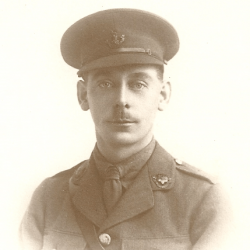Pte. Arthur Slater was hospitalised for Scabies twice during his service in World War One. He was not unusual in this.
The information below is primarily from Medical Services; Diseases of the War, Volume II, by Sir W. G. Macpherson.
Treatment of Scabies in WW1
The principles underlying the treatment of scabies included first, the exposure of the parasite and ova, secondly, their destruction by a suitable parasiticide, and thirdly, disinfection of contaminated articles of clothing and bedding.
Of all remedies, sulphur is generally acknowledged to be the most efficient, and by reason of its procurability and cheapness it was especially suited for the extensive requirements of the army.
During the war many preparations of sulphur were tried. After experiment the old-fashioned plan of inunction with the B.P. ointment was found to be the most satisfactory, although good results were obtained with sulphur in other forms, such as Vlemingkx’s solution*. Reference may be made to the “sulphur vapour treatment,” for it obtained a certain vogue. A number of instances of the after results came under observation. It proved an unsatisfactory and unreliable form of treatment; cure was uncertain, and severe secondary dermatitis common.
The treatment of scabies as adopted by MacCormac may be outlined as follows. On the first day the patient was thoroughly rubbed with soft soap for fifteen minutes. He then entered a warm bath where he lay for twenty minutes; during the last five minutes the infected sites were gently scrubbed with a soft brush. This procedure was designed to open up the burrows and expose the acari and ova. Steam or shower baths could not accomplish this satisfactorily and were therefore unsuitable. After drying, a liberal quantity of sulphur ointment (B.P.) was rubbed over the whole body below the neck, special attention being paid to the hands, feet, and penis. This inunction was repeated on the second and third days. On the fourth day, but not before, the patient was given a second bath and supplied with clean clothing and bedding. Such articles as socks, wrist straps, gloves, and the string of identification discs also required disinfection.
This routine procedure was successful in the vast majority of cases. Occasionally, it caused some degree of dermatitis, a condition easily allayed by simple ointment or dusting powder. This dermatitis was of importance; it usually made its first appearance five to seven days after sulphur treatment had been completed and was associated with itching, and therefore occasionally led to the false conclusion that relapse had occurred.
It should be noted that the preliminary bath was solely intended to expose the parasite and ova, therefore no disinfectant had to be added. In applying the sulphur preparation the whole body below the neck had to be treated, otherwise a few insects might escape destruction, with consequent re-infection. The sulphur ointment was employed on three days only; further application was unnecessary and might cause severe dermatitis. Finally, unless all contaminated material was disinfected, relapse was probable.
In 1918 a pamphlet on scabies was issued to the army. While it represented the result of much careful investigation reference may be made to it since it differed in certain respects from what has been said above. Moreover, dermatologists will hardly concur in the recommendation that the parasiticide liquor calcis sulphuratae should not be allowed to run on to the glans penis. This was a region very commonly found to be infected and therefore required special attention in treatment.
The severe type of scabies commonly met with in France required 31-7 days for cure as against three days for the average early case. But these severe types were in themselves evidence that disease had been present for a considerable time during which the infected man was capable of contaminating others. Early detection, therefore, not only shortened the period of treatment but also served as a means of preventing the spread of disease. Such early detection demanded first, familiarity on the part of the medical officer with the prevalent and unusual type of scabies; and secondly, the provision of sufficient opportunities for complete inspection. Early treatment was complementary to early diagnosis and was of equal importance. It has been shown that 30-29 days elapsed before a man affected with skin disease reached the base. Where treatment was carried out near the front area this figure was reduced, but, on the other hand, the more accessible the unit the less adequate must the means of treatment be unless this duty was undertaken specially. The provision of scabies hospitals for each army corps would seem to satisfy all requirements under conditions of active service, for they would afford early and skilled treatment, thereby both shortening the period of treatment and limiting the opportunities for spreading infection.
* Vleminckx’ solution is an orange-colored solution containing sulfides of calcium made by boiling a mixture of hydrated lime and sublimed sulfur in water and applied externally as a topical antiseptic and scabicide. Also called Sulfurated Lime Solution.

